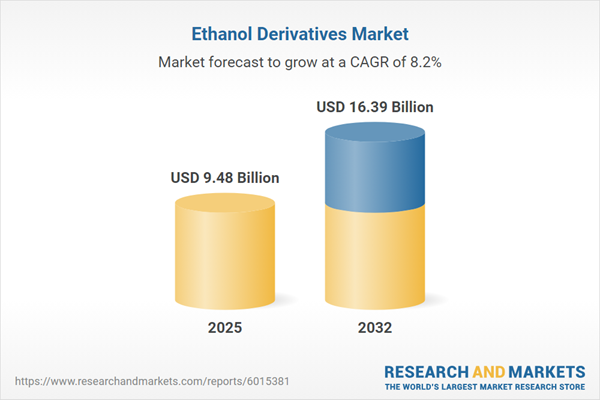Speak directly to the analyst to clarify any post sales queries you may have.
The ethanol derivatives market is evolving rapidly as companies balance sustainable production, regulatory changes, and technology upgrades to stay competitive. Senior leaders require comprehensive, actionable intelligence to navigate these shifts, ensuring operational agility and strategic positioning worldwide.
Market Snapshot: Growth and Trends in the Ethanol Derivatives Market
Global demand for ethanol derivatives is rising, propelled by strict environmental policies and the shift toward bio-based alternatives. Advanced manufacturers are leveraging region-specific strengths, innovation, and resilient supply chains to outperform industry peers. Product development efforts and robust operations are driving progress within the chemicals, pharmaceuticals, and consumer goods sectors. Success in this market increasingly depends on the ability to adapt to regulatory shifts and customize strategies, ensuring increased competitiveness at both local and global levels.
Ethanol Derivatives Market Scope & Segmentation
- Derivative Type: High-purity and standard-grade ethyl acetate support a wide array of industries. Ethylamines (diethylamine, monoethylamine, triethylamine) are integral to advanced manufacturing and specialty chemical applications.
- End-Use Industry: Ethanol derivatives enable innovation in chemicals, pharmaceuticals, and cosmetics, while improving efficiency and extending shelf-life for food and beverage manufacturing. Pharmaceutical companies depend on these compounds to drive safety and innovation in product pipelines.
- Process: Fermentation processes facilitate cost-effective, bio-based production that aligns with global sustainability goals. Synthetic production methods deliver high-purity outputs that meet stringent regulatory standards for demanding end uses.
- Distribution Channel: Direct sales cater to large industrial customers and equipment manufacturers. Local and regional distributors offer custom services and responsiveness to specific sector requirements, supporting differentiated go-to-market strategies.
- Region: The Americas are leading growth, particularly in the United States, Canada, and Brazil. EMEA exhibits expansion across Europe, the Middle East, and select African markets. Asia-Pacific, including China, India, Japan, and Southeast Asia, calls for especially adaptive business models to address diverse regulatory landscapes and customer needs.
- Leading Players: Prominent participants such as China Petroleum & Chemical Corporation, Saudi Basic Industries Corporation, Royal Dutch Shell plc, Exxon Mobil Corporation, Dow Inc., INEOS Group Limited, LyondellBasell Industries N.V., BASF SE, Huntsman Corporation, and Evonik Industries AG are investing in integrated supply chains and technology enhancements.
Key Takeaways for Senior Decision-Makers
- Ethyl acetate and ethylamines are critical inputs that empower innovation for electronics, coatings, and healthcare, contributing to product differentiation and more resilient industry cycles.
- Upgrades to fermentation and synthetic production methods provide manufacturers with needed flexibility to respond to dynamic environmental norms and compliance requirements.
- Digital manufacturing technologies are expanding adoption, offering advanced real-time monitoring and enabling rapid adaptation to regulatory and quality standards.
- Segmenting products by grade and use allows manufacturers to supply highly specialized needs, unlocking value in complex markets such as electronics and medical devices.
- Strategic partnerships facilitate reliable raw material access, foster continuous product improvement, and support growth in regions with demanding compliance requirements or emerging sector opportunities.
- Diversified logistics and sourcing strategies are reinforcing supply chain resilience and minimizing the impact of global trade fluctuations and transport disruptions.
Tariff Impact: United States Trade Policy Shifts
Recent changes in United States trade policy are pushing operational costs higher for ethanol derivative producers and their downstream partners. Industry leaders are mitigating these risks by diversifying supplier bases and evaluating nearshoring strategies to safeguard production. Robust scenario planning and strong internal communication are essential to address potential external shocks.
Methodology & Data Sources
This market analysis is founded on executive interviews, technical literature, proprietary company benchmarking, and global trade data. Peer review and scenario modeling strengthen the relevance and credibility of the insights for decision-makers.
Ethanol Derivatives Market: Why This Report Matters
- Provides clarity on how regulatory changes and variable supply conditions can shape both day-to-day operations and long-term investment outcomes.
- Enables leaders to prioritize market segments and adapt strategies by region, aligning resources efficiently as industry cycles evolve.
- Equips decision-makers to anticipate risk from global trade volatility, regulation shifts, or partnership dynamics with data-driven guidance.
Conclusion
This report delivers the in-depth market intelligence required to guide strategic action in an environmentally conscious and dynamic business environment. Senior executives can leverage these insights to maintain operational strength and outperform in a shifting global market.
Additional Product Information:
- Purchase of this report includes 1 year online access with quarterly updates.
- This report can be updated on request. Please contact our Customer Experience team using the Ask a Question widget on our website.
Table of Contents
3. Executive Summary
4. Market Overview
7. Cumulative Impact of Artificial Intelligence 2025
Companies Mentioned
The companies profiled in this Ethanol Derivatives market report include:- China Petroleum & Chemical Corporation
- Saudi Basic Industries Corporation
- Royal Dutch Shell PLC
- Exxon Mobil Corporation
- Dow Inc.
- INEOS Group Limited
- LyondellBasell Industries N.V.
- BASF SE
- Huntsman Corporation
- Evonik Industries AG
Table Information
| Report Attribute | Details |
|---|---|
| No. of Pages | 190 |
| Published | November 2025 |
| Forecast Period | 2025 - 2032 |
| Estimated Market Value ( USD | $ 9.48 Billion |
| Forecasted Market Value ( USD | $ 16.39 Billion |
| Compound Annual Growth Rate | 8.1% |
| Regions Covered | Global |
| No. of Companies Mentioned | 11 |









